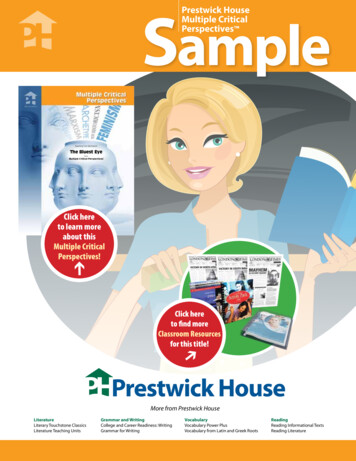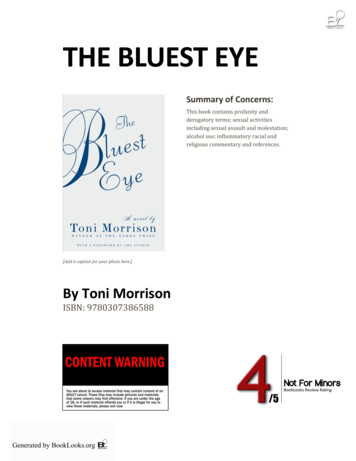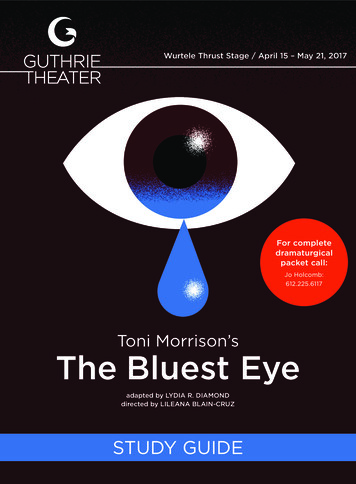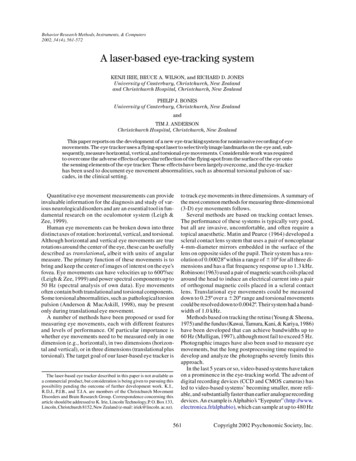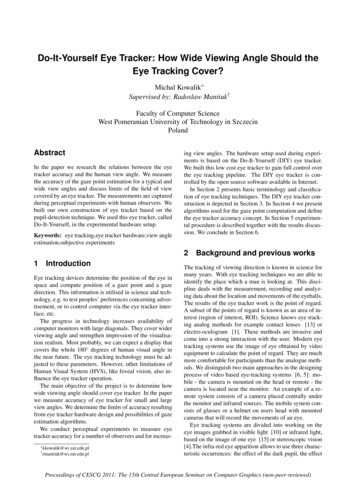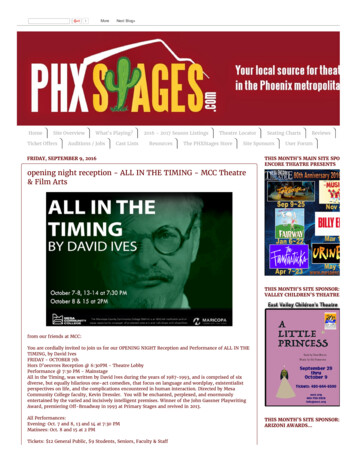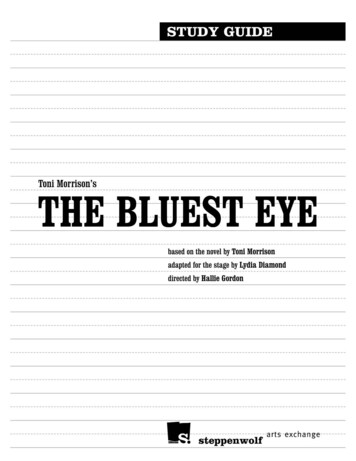
Transcription
The Bluest Eye is the story of a young AfricanAmerican girl and her family who are affected inevery direction by the dominant American culturethat says to them, "You're not beautiful; you're notrelevant; you're invisible; you don't even count."That is what is painful in the novel -- the way inwhich our country has dealt with race, the way inwhich the power structure has hurt us, and the wayin which it has made us hurt ourselves. Oftenenough we African Americans don't get theopportunity to say "This is the source of mydysfunction, and it’s not all my fault."To be shown that when you are young is painful,horrible. On the other hand, it is very affirming tohave all these things made very clear and relevant;things that I knew were sick and wrong, thingsthat touched me in these intangible ways, all madeclear just by having the lives of people like merepresented in literature.-Lydia Diamond, Adaptor
Study Guide ContributorsElinor AndersonBrittany D. BarnesMargot BordelonLydia DiamondLibby FordHallie GordonRJ HoddeJean KahlerBrian LobelJocelyn PrinceTeachers and students can download additional copies of this study guidefor free at www.steppenwolf.org.
yagoodgameplayjane-Table of ContentsAutumnpage 7Claudia and FriedaMamaMrs. BreedloveWinterpage 15Maureen PealSpringpage 19ChollySoaphead ChurchSummerpage 25PecolaPage to Stagepage 29Toni MorrisonAdaptationScript to StageAppendixCharacters in the PlaySetting of the PlayPlot Summary of the PlayOther Works by Toni MorrisonSourcespage 37
eryprettyprettyprettypretty-AutumnClaudia and Friedapage 8StorytellingCommunityRace and BeautyMamapage 10FamilyCommunityMrs. BreedloveFamilyMemoryBeauty and Uglinesspage 12
Claudia and FriedaClaudia and Frieda McTeer are adult sisters remembering events that happened when they werenine and ten years old. Since the story is told through the filter of childhood memory, Claudiaand Frieda speak as children for much of the play, using adult voices only when reflecting onthe events of the play from a future vantage point. They live with their Mama and Daddy, asecure family in a modest home. Claudia is very precocious and observant. Frieda, the oldersister, is more practical and less contemplative than Claudia. Both have strong opinions andvivid imaginations.“Since why is difficult to handle,one must take refuge in how.”StorytellingClaudia and Frieda, the narrators of The Bluest Eye, guideus into the story and establish the framework of memorythat creates the reflective tone of the play. As adults,Claudia and Frieda try to understand why the terribleevents they remember happened, but they cannot.Instead, they tell the story of Pecola's life, hoping thatputting what happened into words will allow them tounderstand it. In telling Pecola's story, they find itnecessary to also tell her parents' stories, which containthe foundations of her life. By using the tangible andimmediate as a means to describe something too complicated and fraught to be easily grasped, they use the howof Pecola's life to approach the why of her disintegration.“Quiet as it's kept, there were nomarigolds in the fall of 1941.”CommunityIn a community and a culture where the adults are not acting as caretakers for their children,children must take responsibility for each other. Claudia and Frieda look after Pecola when shelives with them. They continue to feel responsible for her after she has been raped andimpregnated by her father. In doing so, they shoulder a burden that should be carried by theentire community. They give up hope of buying a bicycle and instead, in an attempt to savePecola’s unborn baby, plant the marigold seeds they have been selling to earn money. Theiroffering, their prayers, and their magic song may be childish, but the girls make a sacrifice oftheir own comfort and privilege, something that no one else in their community is willing to dofor Pecola. They link their lives to hers and hold themselves accountable for her fate.8
The Doll TestDuring the 1940s and ‘50s, the husband and wife team Kenneth and Mamie Clark conducted aseries of psychological experiments examining young black children's relationship to race. Thestudy had several parts, but the "Doll Test" is most remembered today: The Clarks gave veryyoung children otherwise identical brown and white dolls. The children were asked to saywhich doll was "nice," and which was "bad." An overwhelming majority of the black childrenidentified the white doll positively and the brown doll negatively. The results of the studywere cited in the Brown v. Board of Education decision as an indication of the psychologicaldamage done to black children by school segregation.“I had only one desire: to dismember it.”Race and BeautyClaudia and Frieda are given baby dolls for Christmas. Frieda and Pecola adore these whitedolls and Shirley Temple, thinking of the dolls and the little girl with the golden ringlets androsy cheeks as examples of ideal children. When asked why she loves Shirley Temple so much,Pecola says, "She's pretty and talented and people love her." Shirley Temple seems to be all thatPecola is not, and Pecola loves her for it.Claudia, on the other hand, hates Shirley Templein the same way that she hates the blonde,blue-eyed dolls she is given for Christmas.Claudia doesn't know why she should love such adoll, so instead of caring for it, she dissects it,thinking maybe she'll find "what the worldthought was so wonderful about pink skin andyellow hair." Claudia is angry that Shirley Templegets to dance with Mr. Bojanles, a black man, "myfriend, my uncle, my daddy, who ought to havebeen soft-shoeing it and chuckling with me." Itseems to Claudia that the world likes little whitegirls best, and so the dolls become a symbol ofthat preference and a symbol of how she, as a littleblack girl, can never be loved the most.Claudia distrusts the "magic" through which littleShirley Temple and Bojangleswhite girls are able to win the hearts of adults, butPecola believes that if she looked even a little bit like them, people might think she was prettyand would love and take care of her. Claudia does not believe that whiteness equals goodnessand senses the racism inherent in that assumption. A pervasive element of Pecola’s tragedy isher internalization of the disregard with which her community treats her.9
MamaClaudia and Frieda's Mama is an imposing woman with a stern presence. She is more present inthe story than their father, since she works at home, cooking and cleaning and taking care of thechildren. Her priorities are very clear. She will care for her daughters and bring them up right,no matter what it takes. She loves them with a toughness and conviction that leaves little roomfor tenderness but includes a great deal of care.“When I think of autumn,I think of somebody withhands who does not wantme to die.”FamilyAt the beginning of the play, Claudia gets sick. Mamascolds and may seem harsh with her, but Claudiaknows that her anger is directed at the sickness she istrying to cure. Her first concern is Claudia’s and Frieda’shealth: physical, emotional, and moral. Mama is a source ofsecurity and strength for Claudia and Frieda because she has always beenthe steadfast center of their lives. Despite the scolding and the whippings, they know she will doanything for them. Claudia’s and Frieda’s Mama embodies the love and security that Pecola’sfamily lacks. In the play, the unconditional love Mama provides for her daughters contrasts withMrs. Breedlove’s disdain for Pecola. Their family relationships parallel the community supportthat is present for Claudia and Frieda but not for Pecola.“Don't nobody need three quarts of milk.Henry Ford don't need three quarts of milk.”CommunityWhen Pecola comes to stay at their house, Mama agrees to provide for her but will not beimposed upon. When she sees that three quarts of milk have been drunk in one day, sheassumes Pecola drank them and throws a fit, showing Pecola that she can rely on her only if shedoes not ask too much. Ultimately, no one person can take the place of a community insupporting an individual. Because she is poor, because her parents are not from Lorain, andbecause her family is labeled "peculiar," Pecola does not have the support of her community.Mama shows her some kindness, Claudia and Frieda make friends with her, but her place as apart of the town is not secure. Eventually the community abandons her.10
The Great DepressionThe Bluest Eye is set at the end of the Depression, and its effects arestill felt by the characters. It is, in part, because of the Depression thatCholly does not have a job and that waste is so abhorrent to Mama.On Tuesday October 24th, 1929, the Wall Street stock marketcrashed, precipitating the most severe economic crisis in U.S.history: the Great Depression. The stock market crash caused adownward spiral that resulted in over a decade of massunemployment and poverty. By 1933, unemploymentnationwide had risen to 26.6%, and those who were fortunateenough to find work were severely underpaid. Frugality couldmean the difference between having enough food to feed yourfamily and going hungry.Waiting for food in a breadlineIn search of workIn hopes of giving relief to the struggling nation, President Roosevelt established the "NewDeal" programs to create jobs and stimulate economic recovery for the United States. TheCivilian Conservation Corps, Civils Works Administration, Works Progress Administration,and other government offices instituted by Roosevelt employed millions in many differentcapacities. Although the New Deal assisted greatly, it was not until World War II thatemployment returned to a normal level and most of the poverty and destitution associatedwith the Great Depression came to an end.President Roosevelt with a friend11
Mrs. BreedlovePauline Breedlove is Pecola's mother. She lives in a hastily converted storefront with her husband,Cholly, and her children, Pecola and Sammy. She works as a maid for a rich, white family. Whenshe was a girl, Mrs. Breedlove stepped on a nail and injured her foot, causing her to walk with alimp for the rest of her life. She blames the beginning of her unhappiness on her foot, but sheremembers when her dreams seemed attainable.“I didn't mind that he sometimesdrank too much, 'cause it seem likewe was all the time laughing.”MemoryMrs Breedlove narrates parts of The Bluest Eye, and her memoriesprovide the context for Pecola's experiences. While Claudia andFrieda are the primary narrators for the events that occur in their lifetimes, Mrs. Breedlove’s voiceis heard when the play moves into the past. Her oral history of her family helps explain the painand violence of Pecola’s life. Mrs. Breedlove’s unhappiness at Pecola’s birth instigates Pecola’sself-loathing and conviction of her own ugliness. Mrs. Breedlove describes the traumatic experiences of Cholly’s youth with empathy. Her point of view adds dimension to Cholly, who wouldotherwise appear to be only violent and destructive. Mrs. Breedlove’s memories provide a pictureof the circumstances of her family and her community that produce Pecola’s tragic life.The Great MigrationIn the period between 1916 and the 1960s, more than six million Southern black people moved to theNorth. Cholly and Mrs. Breedlove left the rural South as a part of this trend, as did many AfricanAmericans who came to populate Lorain and other Midwest towns.Like many northern towns with industrial economies, Lorain was a destination of this “GreatMigration”. The end of the Civil War and emancipation of slaves did not result in racialequality in the South. Lynching continued, Jim Crow laws limited the rights of black people,and the transition out of a slave-based economy resulted in economic hardship for everyone,especially for the former slaves. In the late 1800s, black people started moving north in searchof jobs and greater racial tolerance. This migration increased dramatically in the early 20thcentury, largely in response to an increased number of unskilled factory job openings innorthern companies during World War I.12
“I settled down to being ugly.”Beauty and UglinessWhen Mrs. Breedlove was young, she dreamed of falling in love. She wanted to be carried awayby a man who possessed, "tenderness, strength, and a promise of rest," and one day Cholly camealong and swept her off her feet. He kissed the injured foot she had thought made her unworthyof attention, and they fell in love. She followed him to Ohio and settled down to live the simple,happy, love-filled life of her daydreams.When she was five months pregnant with her first child, Mrs. Breedlove lost her front tooth on apiece of candy. She'd learned from going to the movies that to be happy you had to wear prettyclothes and have a lovely smile. Missing a tooth, irreparably flawed according to Hollywoodvalues, she gave up on her hopes of glamour or even happiness. The reality of her Depressionera life in a small, dusty, Midwest town did not measure up to the standard of her dreams, soshe told herself she was ugly and worthless.“Don't you worry none baby They weren't nobody.”FamilyMrs. Breedlove's life exists in a tension between the cleanliness and order of the house where sheworks and the dirt and chaos of her home. Pecola and Sammy are a part of the dirty, ugly worldthat she escapes by going to work, soMrs. Breedlove distances herself fromthem as well as from Cholly. Rather thantry to fix the imperfect by attempting tobring home some of the order andcontrol she finds at work, Mrs. Breedloveputs energy into a world which is notreally hers. She carries out her duty tosupport her children, but she does notlook to them as a source of happiness.13
ecatitgoesme
The Bluest Eyeis set at the end of the Depression, and its effects are still felt by the characters. It is, in part, because of the Depression that Cholly does not have a job and that waste is so abhorrent to Mama. On Tuesday October 24th, 1929, the Wall Street stock market crashed, precipitating the most severe economic crisis in U.S.
